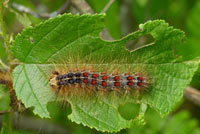Gypsy Moth

Is it a GYPSY MOTH? Gypsy Moth hitchhikes from site to site on firewood, vehicles, trailers/loads as egg masses (August - May) or caterpillars (May - July). Each egg mass can hatch 600 -1000 caterpillars.
KEY FEATURES. Time of year is important. Not all fuzzy striped and spotted caterpillars are gypsy moth.
- June - July. Caterpillars 1.5" to 2", bristly, blue and red dots, head is yellow with black markings. Do not weave tents or webs. Usually the most seen life stage when caterpillars migrate to protected niches to pupate into moths.
- July. Hard-cased, immobile pupae; dark brown. These emerge as moths in mid-July.
- August. Non-feeding moths emerge to mate and die. Females are snowy white with black specks. Females DO NOT FLY. She will lay a brown velveteen-textured egg mass that will overwinter and hatch next spring.
- Mid-August - late April. Egg masses only. No gypsy moths or caterpillars survive past August.
- Late April. Eggs hatch
- May - June. Tiny fuzzy black caterpillars begin feeding when oak leaves emerge. Caterpillars go through 4 - 5 instars (growth stages).
What to do:
- If it is gypsy moth, determine the extent and severity of the infestation.
- Tell your neighbors. Gypsy moth easily moves over property lines. Neighbors working together makes a difference in early control measures.
- Yards - What You Can Do during a gypsy moth caterpillar outbreak and for seasonal maintenance in fall and spring.
- Woodlots - "Forest Management Strategies to Minimize the Impact of Gypsy Moth"
- If it's bad and beyond your ability to control, contact a certified arborist.
- DNR Gypsy Moth hotline - 1-800-642-MOTH
- Contact your municipality.
- Rock County Land Conservation - 608-754-6617 ext. 4758.

